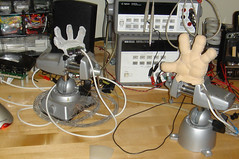Innovation doesn’t occur when something new is created. Innovation occurs when people start behaving differently. There are a many factors at play when examining what and why people do things one way and not another.

If a new behavior requires the use of an object or tool, how well that object or tool is suited to amplifying our existing human capabilities is one factor of whether the new behavior is adopted. This is haptics.
Another factor is how the new behavior fits into our social existence. This includes things like whether or not the new behavior has an influence on our social standing (status) or whether it improves our ability to do things with other people (collaboration).
Haptics occur in the hands, social occurs in the mind.
Sometimes these two factors—social and haptics—overlap. In some cases the tool itself confers status or collaboration. For example, when I was in Bulgaria in the late ’90s it was very fashionable to own a cell phone (a tool of collaboration). Possession of a cell phone among certain groups was seen as being so socially desirable that there was a market for inexpensive fake cell phones. The social haptics of cell phones were so desirable that a new market product was created. This new product’s sole function was to look like a real cell phone and be seen by people other than the person possessing it.
Social haptics provides us with a means of considering the periphery of a technology object. While the specific features and problems a technology solves are often at the forefront of a product designers mind, the periphery can get lost. That periphery, how the object gets used in society, can determine the success of the object. Social haptics provides a useful lens to examine new technologies.
[blackbirdpie id=”232276795699888128″]
An example of a social haptics problem would be the forward camera built into Apple’s iPad. In order to use the camera a person has to hold the iPad at head height instead of at the usual book height position. This is a gesture which is bound to draw attention as it rarely occurs that someone holds such a large object this way. It is at this moment that the challenge of taking a photograph with an iPad changes from a problem of haptics–“how do I hold this thing and take a photo at the same time?”–to a social problem–“I look like an idiot.”
The same device, however, excels in other areas of social haptics. For example, sharing screen-based information with someone in the same room by handing them an iPad is a significantly more collaborative experience than passing a laptop or smart phone back and forth. For this particular activity the iPad has excellent social haptics.

A product like Google’s Project Glass, which delivers data to individuals via a pair of glasses, presents a different set of social haptics issues. As a device focused on individual use, it likely won’t have great collaboration capabilities. Glasses are considered very personal objects and are rarely passed back and forth between people.
On the other hand, using all of its other features should be relatively unobtrusive. In this way, the social haptics of the device work to obscure the existence of the technology to those not using it. Something that presents a degree of social risk depending on how others feel about the data sets being used surreptitiously in their presence.
The Project Glass object itself will also be a fashion object, like prescription glasses. In this way it may be a noticeable object among those who recognize it. Sort of like recognizing a particular brand of shoes or handbag. This social recognition of the technology may confer status or it could present a risk in the same way that that iPods and Nike shoes have been targeted for theft. It may also present a variety of legal and physical security challenges for organizations and users of these kinds of technologies. These changes in human behavior are also innovations.

Somewhere along the way, the challenges a technology solves or presents becomes enmeshed in challenges of how people collaborate and confer status upon one another. Unlike the shape of our hands and the capabilities of our bodies, these social factors are constantly changing. An object’s adoption rate and longevity are influenced by the combination of these things—the social haptics.
